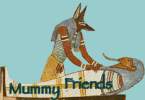The Egyptian Alphabet
There are over 700 common heiroglyphs, but these 25 cover all the sounds of the Egyptian language and were used by the Egyptians themselves to "sound out" unfamiliar words. The order of the letters is standard, but modern.
| Hieroglyph | Value | Pronunciation | |
|---|---|---|---|
| Eagle |  |
Originally a "glottal stop" like the sound between the two syllables of "uh-oh". Pronounced as a vowel "a" as in "father" by American Egyptologists. | |
| Reed |  |
Like "i" in "this". | |
| Double Reed |  |
Before a vowel, like "y" in "yes". Otherwise like "y" in "many". | |
| Arm |  |
Originally a consonant made far back in the throat. Pronounced as a long vowel "ay" as in "day" by American Egyptologists. | |
| Quail chick |  |
Before a vowel, like "w" in "wood". Otherwise like a long "oo" as in "too". | |
| Leg |  |
Like "b" as in "boy". | |
| Window shutter |  |
Like "p" as in "pea". | |
| Asp |  |
Like "f" as in "find". | |
| Owl |  |
Like "m" as in "more". The word "m" ("in") is pronounced "em". | |
| Water |  |
Like "n" as in "new". The word "n" ("of") is pronounced "en". | |
| Mouth |  |
Like "r" as in "red". The word "r" ("to") is pronounced "er". | |
| House |  |
Like "h" as in "how". | |
| Coil of rope |  |
Like "h" as in "how", only stronger. | |
| Placenta |  |
Like "ch" as in the German "ach". | |
| Animal belly |  |
Like "ch" as in the German "ich", but most people pronounce it the same as the letter above. | |
| Folded cloth |  |
Like "s" as in "say". The word "s" ("man") is pronounced "se" | |
| Door bolt |  |
Like "z" as in "zero", but most people pronounce it the same as the letter above. | |
| Pool |  |
Like "sh" as in "shoe". | |
| Knee |  |
Like a "q" pronounced far back in the throat, but most people pronounce it as "k". | |
| Cup |  |
Like "k" as in "king". | |
| Chair back |  |
Like "g" as in "go". Never soft like "j" as in "join". | |
| Loaf of bread |  |
Like "t" as in "take". | |
| Rope |  |
Like "ch" as in "cheese". | |
| Hand |  |
Like "d" as in "door". | |
| Snake |  |
Like "j" as in "join". | |
Important Note: We really have no idea how ancient Egyptian was pronounced, so don't worry about trying to get it "right". Most American Egyptologists use the pronunciations above and also insert a short "e" between any combinations of consonants that are too hard to pronounce.







